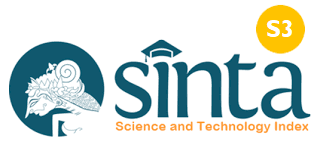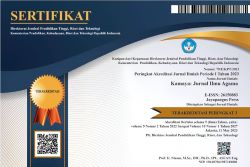Pandita Dalam Teks Lontar Tutur Gong Besi
DOI:
https://doi.org/10.37329/kamaya.v6i2.2209Keywords:
Pandita, Tutur Gong BesiAbstract
The institutionalization of Hindu religious teachings, especially the Siwaistic understanding, is inextricably linked to the duty of the clergy,who in this case are certainly more dominated by Pandita/Sulinggih. Pandita means learned, scholar, teacher, teacher, especially one who studies and is an expert in the spiritual field; wise men, saints, brahmanas, wiku, rsi, priests. Descriptive qualitative method used in this study. The purpose of this research is to ascertain the teachings of the priesthood contained in the lontar text of Gong Besi. The lontar text of Tutur Gong Besi states that a Pandita is said to be perfect if he knows the nature of life as a human being, is able to distinguish worldly things (sakala) which causes attachment to maya. Additionally to understanding the true things that are actually the goal of human life (things related to abstraction). Thus, a Pandita must always purify himself and master religious teachings so that he can appropriately do his tasks as a guide for the people.
References
Adhimastra, I K. (2016). Visualisasi Lontar Tutur Gong Besi untuk Visualisasi Arsitektur Tradisional Bali. Anala, 4, 1–6.
Ambarnuari, M. (2019). Upacara Ngaben Warga Panyuwungan Di Desa Abianbase Gianyar. Pangkaja, 22(2), 23–33.
Arimbawa, I N. N. S. (2018). Mudra Pandita Siwa. Denpasar: Pustaka Bali Post.
Harsananda, H. (2015). Ajaran Teologi dalam Teks Tutur Gong Besi. Denpasar: Institut Hindu Dharma Negeri Denpasar.
Harsananda, H., & Maheswari. (2020). Ajaran Eskatologi Dalam Teks Tutur Gong Besi. 11(2), 131–145.
Kajeng, I. N., dkk. (1997). Sarasamuccaya. Denpasar: Paramitha.
Kariarta, I. W., & Suantini, N. W. (2020). Ajaran Kepanditaan dalam Teks Tattwa Dhangdhang Bang Bungalan. ŚRUTI: Jurnal Agama Hindu, 1(1), 81-92.
Miartha, I. W. (2015). Diksanisasi Teogeneologis-Teoantropologis. Denpasar: Yayasan Santha Yana Dharma MGPSSR.
Ngurah, N. . G., & Wiratmadja, I. A. (2012). Murddha Agama Hindu. Upada Sastra.
Pals, D. L. (2012). Seven Theories Of Religion (2nd ed.). Jakarta: IRCiSoD.
Saitya, I. B. S., & Indrayani, A. D. (2020). Paṇḍita Dalam Teks Agastya Parwa. Kamaya: Jurnal Ilmu Agama, 3(3), 298-307.
Sandika, I. K. (2018). Siwa Tattwa (Ajaran Spiritual Leluhur Nusantara). Bali Wisdom.
Shasangka Damar. (2015). Ilmu Jawa Kuna (Sanghyang Tattwajnana Nirmala Nawaruci). Jakarta: Dolphin.
Suhardana, K. M. (2008). Dasar-Dasar Kesulinggihan: Suatu Pengantar Bagi Sisya Calon Sulinggih. Denpasar: Paramita.
Tim Penerjemah. (1994). Buana Kosa (Brahma Rahasyam) Alih Aksara dan Alih Bahasa. Denpasar: Upada Sastra.
Tim Penerjemah. (2002). Alih Aksara dan Terjemahan Tutur Gong Besi Tutur Lebur Gangsa Tutur Angkus Prana. Dinas Kebudayaan Provinsi Bali.
Titib, I. M. (1996). Veda Sabda Suci : Pedoman Praktis Kehidupan. Denpasar: Paramita.
Widyawati A.A. A. A. (2020). Upacara Menek Deha. Pangkaja, 23 (2) 28-41.
Downloads
Published
How to Cite
Issue
Section
License
Copyright (c) 2023 Kamaya: Jurnal Ilmu Agama

This work is licensed under a Creative Commons Attribution-ShareAlike 4.0 International License.
An author who publishes in the Kamaya : Jurnal Ilmu Agama agrees to the following terms:
- Author retains the copyright and grants the journal the right of first publication of the work simultaneously licensed under the Creative Commons Attribution-ShareAlike 4.0 License that allows others to share the work with an acknowledgement of the work's authorship and initial publication in this journal
- Author is able to enter into separate, additional contractual arrangements for the non-exclusive distribution of the journal's published version of the work (e.g., post it to an institutional repository or publish it in a book) with the acknowledgement of its initial publication in this journal.
- Author is permitted and encouraged to post his/her work online (e.g., in institutional repositories or on their website) prior to and during the submission process, as it can lead to productive exchanges, as well as earlier and greater citation of the published work (See The Effect of Open Access).
Read more about the Creative Commons Attribution-ShareAlike 4.0 Licence here: https://creativecommons.org/licenses/by-sa/4.0/.





